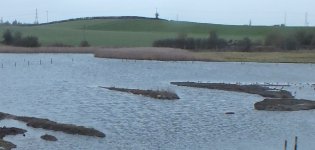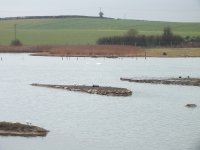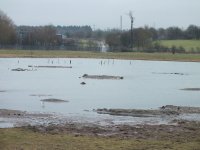Today at the reserve
For a change started at the Flashes, owing to the cold W/NW more than any great bird expectations.
The rain was almost continuous until mid-day and later this afternoon the sun warmed things up a bit , but it was never more than 8 degrees.
Andy P got me my first sand martin on the sailing pool, it soon disappeared and probably went back south8-P.
Cettis sang both at the sailing pool and the Flashes as well as the 2 at the Moors. The avocets were again nervous and flighty, due to sewage workers maintaining the green tanks. This happened last year at the same time, the birds eventually got used to it and the work finished in April. The reed cutting around the meadow has opened up this area and several waders and coot fed in the cut section. Teal as always in March declined in number.
On to the Moors east hide, where noticeably shovelers had increased. There were several parties of thrushes and starlings moving through to the NW. Snipe were conspicuous feeding on the saturated ground but Pochard again had vacated the reserve.
Finally, a quick look over the North Moors revealed a bit of activity and it is hoped that the habitat improvements will see an upsurge in waterfowl in and around the pool.
Species Counts:-
FLASHES: teal 19, shelduck 3, mute swan pr, coot 21, AVOCET 28, curlew 9, snipe 20, oystercatcher pr, lapwing pr - later joined by 10 dropping in. BHG 150, herring gull, buzzard, kestrel, stock dove, skylark, cettis w, goldcrest pr, starling 20, song thrush 2
SAILING POOL: GCG 2, tufted 6, coot 8, cettis w, song thrush
MOORS: Little Egret 3, GCG 5, little grebe 5 (2 Broadmeadow pool), cormorant c20, shoveler 61, teal 12, gadwall 5 (2 prs + m), shelduck 2, tufted c55, coot 100 ish, water rail, snipe 15, lapwing 6, oystercatcher 4, kestrel, buzzard, sparrowhawk, green woodp, kingfisher, stock dove, redwing c45, fieldfare 35, starling c 30, cettis w 2, chaffinch 2, bullfinch, goldfinch 2,
NORTH MOORS: Little grebe, gadwall pr, teal 4, coot, moorhen 3. Rich saw a treecreeper in the plantation earlier this week.
NB: I spoke to the geazer who saw the Barn Owl on 11th March. It flew along the east side of the NM and then disappeared into the plantation. It probably then flew past 'Lifestyles'.B










